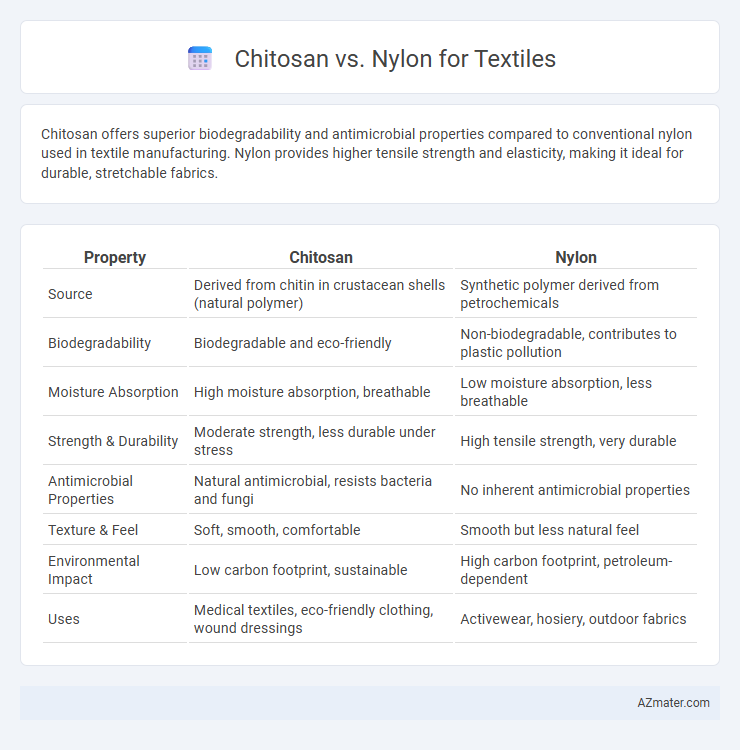Chitosan offers superior biodegradability and antimicrobial properties compared to conventional nylon used in textile manufacturing. Nylon provides higher tensile strength and elasticity, making it ideal for durable, stretchable fabrics.
Table of Comparison
| Property | Chitosan | Nylon |
|---|---|---|
| Source | Derived from chitin in crustacean shells (natural polymer) | Synthetic polymer derived from petrochemicals |
| Biodegradability | Biodegradable and eco-friendly | Non-biodegradable, contributes to plastic pollution |
| Moisture Absorption | High moisture absorption, breathable | Low moisture absorption, less breathable |
| Strength & Durability | Moderate strength, less durable under stress | High tensile strength, very durable |
| Antimicrobial Properties | Natural antimicrobial, resists bacteria and fungi | No inherent antimicrobial properties |
| Texture & Feel | Soft, smooth, comfortable | Smooth but less natural feel |
| Environmental Impact | Low carbon footprint, sustainable | High carbon footprint, petroleum-dependent |
| Uses | Medical textiles, eco-friendly clothing, wound dressings | Activewear, hosiery, outdoor fabrics |
Introduction to Chitosan and Nylon in Textiles
Chitosan, a natural biopolymer derived from chitin in crustacean shells, offers biodegradability, antimicrobial properties, and excellent moisture management in textile applications. Nylon, a synthetic polyamide, is prized for its high tensile strength, elasticity, and durability, making it suitable for a wide range of textile products like activewear and industrial fabrics. The choice between chitosan and nylon impacts fabric performance, sustainability, and end-use suitability in the modern textile industry.
Chemical Structure and Origins
Chitosan, derived from chitin found in crustacean shells, features a biopolymer composed of b-(1-4)-linked D-glucosamine units, providing biodegradability and antimicrobial properties. Nylon, a synthetic polyamide produced through the polymerization of diamines and dicarboxylic acids, consists of repeating amide bonds contributing to its strength and durability. The chemical structure and natural origins of chitosan contrast with the fully synthetic, petroleum-based origin of nylon, influencing their environmental impact and functional applications in textiles.
Environmental Impact and Sustainability
Chitosan fibers, derived from renewable resources like crustacean shells, offer superior biodegradability and lower environmental impact compared to petroleum-based nylon, which is non-biodegradable and contributes to microplastic pollution. The production of chitosan requires less energy and generates fewer greenhouse gases, aligning with global sustainability goals in textile manufacturing. Utilizing chitosan in textiles supports circular economy principles, reducing reliance on fossil fuels and minimizing waste accumulation in ecosystems.
Mechanical Properties and Durability
Chitosan fibers exhibit superior biodegradability and antimicrobial properties but generally show lower tensile strength and elongation at break compared to nylon, which offers exceptional mechanical strength and durability under repeated stress. Nylon demonstrates higher abrasion resistance and better resilience against environmental factors such as UV exposure and moisture, making it more suitable for long-term textile applications. However, chitosan's biocompatibility and eco-friendly nature position it as a sustainable alternative in specialized textile uses requiring moderate mechanical properties.
Biodegradability and End-of-Life Scenarios
Chitosan fibers outperform nylon in biodegradability, decomposing naturally within months in soil or compost environments, significantly reducing environmental impact. Nylon, a synthetic polymer, resists degradation and persists for decades in landfills or marine settings, contributing to microplastic pollution. End-of-life management of chitosan textiles supports circular economy principles through composting, whereas nylon requires energy-intensive recycling or disposal processes, making chitosan a sustainable alternative for eco-friendly textile applications.
Moisture Management and Breathability
Chitosan fibers exhibit superior moisture management compared to nylon due to their natural hydrophilic properties, which enable efficient absorption and release of sweat, enhancing wearer comfort in activewear and sports textiles. In contrast, nylon's hydrophobic nature limits moisture absorption but offers quicker drying times. Breathability in chitosan textiles benefits from the biopolymer's porous structure, promoting air circulation and reducing heat retention, whereas nylon fabric breathability depends on fabric construction techniques, often requiring engineering modifications to improve ventilation.
Antimicrobial and Allergenic Properties
Chitosan, a natural biopolymer derived from chitin, exhibits strong antimicrobial properties by inhibiting bacterial growth and reducing odor in textiles, making it ideal for medical and activewear applications. Nylon, a synthetic polymer, lacks inherent antimicrobial effects and often requires additional chemical treatments to prevent microbial activity, which may cause skin irritation in sensitive individuals. Chitosan's hypoallergenic nature and biodegradability provide safer, eco-friendly alternatives compared to nylon, which can trigger allergic reactions due to its synthetic additives and surface treatments.
Cost and Scalability for Textile Production
Chitosan offers a sustainable and biodegradable alternative to nylon, with a higher cost due to complex extraction and processing methods, impacting its scalability for large-scale textile production. Nylon remains cost-effective and highly scalable, benefiting from established manufacturing infrastructure and economies of scale. Textile industries prioritize nylon for mass production, while chitosan is gaining traction in niche markets emphasizing eco-friendly materials.
Fashion and Functional Applications
Chitosan fibers offer biodegradable and antimicrobial properties, enhancing fashion textiles with sustainable and hygienic benefits, unlike traditional nylon which is synthetic and non-biodegradable. In functional applications, chitosan provides moisture regulation and odor resistance, making it ideal for activewear and medical textiles, while nylon excels in durability and elasticity for performance-focused garments. The choice between chitosan and nylon depends on prioritizing eco-friendliness and health benefits or strength and flexibility in fashion and functional textile uses.
Future Prospects and Industry Trends
Chitosan, derived from natural biopolymers, offers sustainable advantages over traditional nylon in the textile industry due to its biodegradability and antimicrobial properties, aligning with growing environmental regulations and consumer demand for eco-friendly fabrics. Innovations in chitosan blending and fiber spinning technologies are enhancing its durability and cost-effectiveness, positioning it as a viable alternative to synthetic nylon in performance textiles. Industry trends indicate increasing investment in biopolymer research and a shift toward circular economy practices, driving future growth opportunities for chitosan-based textiles.

Infographic: Chitosan vs Nylon for Textile
 azmater.com
azmater.com